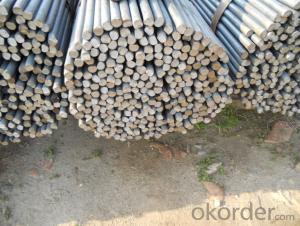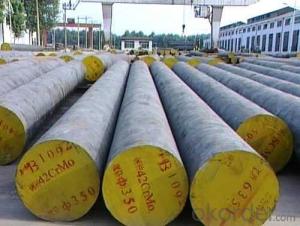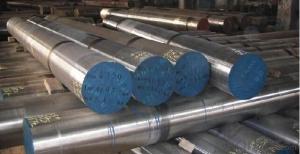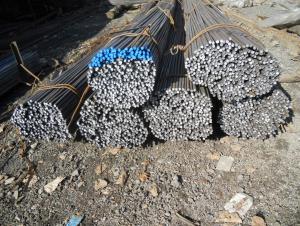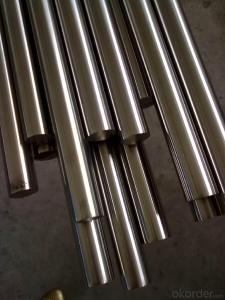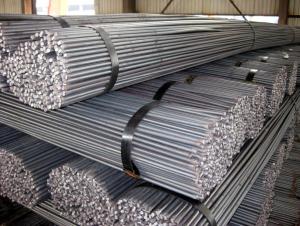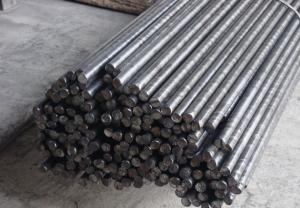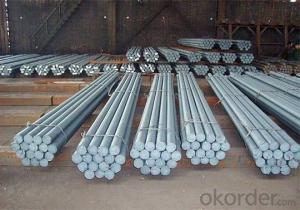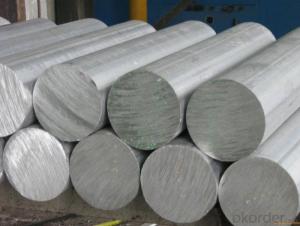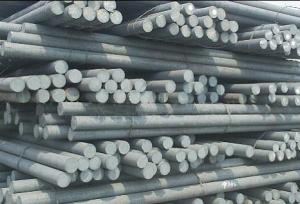alloy round steel bar JIS /GB/DIN STANDAR
- Loading Port:
- Shanghai
- Payment Terms:
- TT OR LC
- Min Order Qty:
- 100 m.t.
- Supply Capability:
- 100000 m.t./month
OKorder Service Pledge
OKorder Financial Service
You Might Also Like
Product Description:
Specifications of Hot Rolled Round Bar
1. Grade: Q235, SS400, A36, S235JR
2. Diameter: 6mm—150mm
3. Length: As customer’s request, but we usually produce 6m, 9m and 12m
4. Steel Grade: Mild carbon steel
5. Characteristics: Has a good harden ability, high hardness, wear resistance, heat distortion, etc. So it can be used in the production of heavy duty and complex shape mold.
6. Main Markets: Mid East, Southeast Asia, Africa, Oceania, Eastern Asia, Central America and South America, etc.
Usage and Applications of Hot Rolled Round Bar
1. Hot rolled round bar of 6-25mm, or small round is mostly used for straight bundles supply, and used for steel, bolts and various mechanical parts. While the bigger round bar, or more than 25mm hot rolled bar, is mainly for the manufacture of mechanical parts or for seamless steel billet.
2. Besides, we can supply some especial material steel round bar that can be used for main shaft of steamer, hummer shank, with big section and supper force.
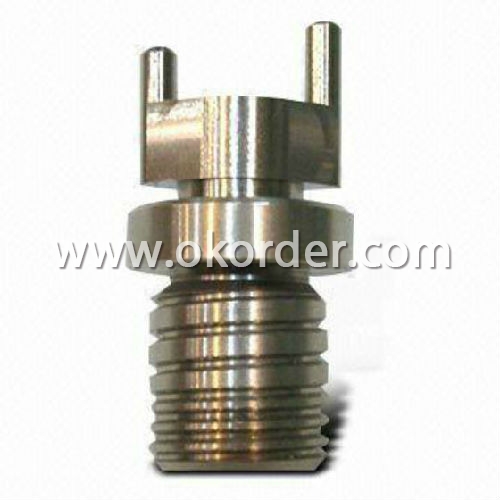
Packaging & Delivery of Hot Rolled Round Bar
Packaging Detail: All goods are packed in bundle with steel strips and shipped by break bulk vessel or container (depend on target market and different ports)
Delivery Detail: 45 days
Trade terms: FOB, CFR, CIF
MOQ: 25 tons per specification; we can negotiate the quantity if the specification is normal or we have stock of one specification.
Weight: The price invoicing on theoretical weight basis or actual weight basis depends on customer’s request.
Shipment: The shipment of bulk break or container is depends on customer’s request and the situation of the port of destination.
Documents given: Full set of original clean on board bill of lading; Original signed commercial invoice; Original packing list; Policy of insurance; Certificate of origin and what the target market needs.
Production Flow of Hot Rolled Round Bar
We use advanced equipments like Electric Arc Furnace, Ladle Furnace and Vacuum Degasser to produce our products.
The common processes are preheated forging quenching, dual refinement solution process, cooling quenching and isothermal quenching. We use heat treatment for dual refinement solution process. The main measures process is high temperature solution and refinement cycle. High temperature solution can improve the carbide morphology and particle size. The aim is to make the loop refinement ultrafine austenite grains.
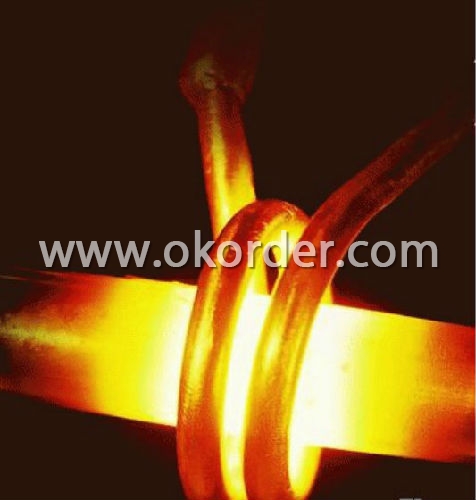
Quality Assurance of Hot Rolled Round Bar
1. We will strictly inspect our production that we sold according to the customer’s request.
2. Quality should be in conformity with the specification of the manufacturer. Quantity and packing conditions should be in conformity with the term in the contract.
3. Should the packing found damaged, the buyer has the right to claim to the seller.
- Q: What is the impact strength of a steel round bar?
- The impact strength of a steel round bar refers to its ability to withstand sudden applied forces or shock loads without fracturing or breaking. It is usually measured in terms of energy absorbed during impact testing, such as the Charpy or Izod test. The exact impact strength can vary depending on the specific grade and heat treatment of the steel, but steel round bars are generally known for their high impact strength, making them suitable for applications requiring resistance to sudden impacts or dynamic loads.
- Q: What are the different surface treatments available for tool steel round bars?
- There are several surface treatments available for tool steel round bars, which are used to enhance the performance, durability, and overall quality of the steel. Some of the common surface treatments for tool steel round bars include: 1. Nitriding: This process involves exposing the tool steel to a nitrogen-rich environment at high temperatures. It forms a hard surface layer that improves wear resistance and reduces friction. 2. Coating: Tool steel round bars can be coated with various materials such as titanium nitride (TiN), titanium carbonitride (TiCN), or chromium nitride (CrN). These coatings provide excellent resistance to wear, corrosion, and heat. 3. Black oxide: It is a chemical treatment that forms a black oxide layer on the surface of the tool steel. This treatment improves corrosion resistance and reduces the risk of rusting. 4. Heat treatment: Tool steel round bars can undergo heat treatment processes such as annealing, tempering, or quenching. These treatments help to improve the hardness, strength, and toughness of the steel. 5. Surface grinding: This process involves removing a thin layer of material from the surface of the tool steel. It helps to achieve a smooth and polished surface, enhancing the aesthetics and reducing the risk of surface defects. 6. Shot peening: It is a process where small metal or ceramic particles are propelled onto the surface of the tool steel at high velocity. This treatment induces compressive stress, improving the fatigue resistance and extending the lifespan of the steel. 7. Electropolishing: This treatment involves immersing the tool steel in an electrolyte bath and applying an electric current. It helps to remove surface imperfections, enhance the surface finish, and improve corrosion resistance. These surface treatments can be chosen based on the specific requirements and applications of the tool steel round bars. Each treatment offers unique benefits and can significantly enhance the performance and longevity of the tool steel.
- Q: Can steel round bars be used for making wire?
- Yes, steel round bars can be used for making wire. Steel round bars can be processed into wire by a process called wire drawing. In this process, the steel round bar is pulled through a series of progressively smaller dies to reduce its diameter until it reaches the desired wire size. This process is commonly used in the manufacturing of various types of wire, including steel wire used in construction, electrical wiring, fencing, and other applications. The steel round bars used for making wire are typically made from carbon steel, which provides the necessary strength and durability for the wire to be used in various applications.
- Q: What are the different types of steel round bar surface defects?
- There are several types of steel round bar surface defects, including pits, roll marks, scratches, cracks, scale, and decarburization.
- Q: How do you measure the hardness of a steel round bar?
- The hardness of a steel round bar can be measured using various methods, with the most common being the Rockwell hardness test. In this test, a diamond or steel ball indenter is pressed into the surface of the steel at a specific load, and the depth of the indentation is measured. The hardness value is determined based on the depth of the indentation and the applied load. Other methods like Brinell and Vickers hardness tests can also be used, depending on the specific requirements and characteristics of the steel.
- Q: What are the different finishes available for steel round bars?
- There are several different finishes available for steel round bars, each of which serves a specific purpose and provides distinct benefits. Some of the most common finishes include: 1. Hot Rolled: This finish is achieved by heating the steel above its recrystallization temperature and then rapidly cooling it. It results in a rough, scaly surface texture that provides excellent corrosion resistance and durability. 2. Cold Rolled: In this process, the steel is rolled at room temperature, resulting in a smooth and polished finish. Cold rolled steel round bars are known for their precise dimensions, tight tolerances, and improved surface finish. 3. Bright Drawn: This finish involves subjecting the steel round bars to a drawing process, where they are pulled through a die to achieve the desired shape and size. It leaves the surface smooth, bright, and free from any imperfections or defects. 4. Polished: Polishing is typically done after the steel round bars have been cold rolled or drawn. It involves using abrasive materials or chemical treatments to remove any surface imperfections and create a highly reflective finish. Polished steel round bars are often used in decorative applications. 5. Ground: Grinding is a process where the steel round bars are subjected to abrasive wheels to remove any surface imperfections or irregularities. It results in a smooth and even finish, making the bars suitable for applications where tight tolerances and uniformity are required. 6. Galvanized: Galvanizing is a coating process where the steel round bars are dipped in a bath of molten zinc. This creates a protective layer that prevents corrosion and increases the lifespan of the bars, making them suitable for outdoor applications or environments with high humidity or moisture. These different finishes offer a range of properties and appearances, allowing steel round bars to be used in various industries and applications such as construction, automotive, manufacturing, and engineering. It is important to consider the specific requirements and conditions of the intended use when selecting the appropriate finish for steel round bars.
- Q: What is the difference between a smooth and a precision ground steel round bar?
- A smooth steel round bar refers to a steel rod that has a plain surface without any specific surface treatment or finishing process. It is typically produced through hot rolling or cold drawing methods, resulting in a basic cylindrical shape with a relatively rough surface texture. Smooth steel round bars are commonly used in various applications where a smooth exterior finish is not a critical requirement. On the other hand, a precision ground steel round bar undergoes an additional manufacturing process to achieve a more precise and refined surface finish. The precision grinding process involves removing any imperfections or irregularities from the surface of the steel rod, resulting in a highly smooth and polished finish. This process ensures that the diameter of the round bar remains consistent along its length and that the surface has a superior level of finish and accuracy. Precision ground steel round bars are widely used in applications that demand tight tolerances, precision machining, or where a smooth and polished surface is essential. Industries such as aerospace, automotive, tooling, and manufacturing often rely on precision ground steel round bars for their high-quality surface finish, dimensional accuracy, and reliable performance. In summary, the main difference between a smooth and a precision ground steel round bar lies in the surface finish and level of precision achieved. While a smooth steel round bar has a basic, rough surface texture and is suitable for general applications, a precision ground steel round bar undergoes additional grinding processes to achieve a highly smooth, polished, and accurate surface finish, making it ideal for applications requiring tight tolerances and precision machining.
- Q: Can steel round bars be used for making fencing?
- Indeed, fencing can be made using steel round bars. In the construction industry, steel round bars find wide usage for diverse purposes, one of which is fencing. Thanks to its robustness and durability, steel proves to be an appropriate material for creating a strong and enduring enclosure. By welding or bolting steel round bars together, various fencing designs and configurations can be effortlessly formed. Moreover, steel can be galvanized or coated to augment its resistance against corrosion, rendering it suitable for outdoor fencing purposes. All in all, steel round bars are a versatile and dependable option for constructing fencing structures.
- Q: Can steel round bars be used in the production of tools?
- Certainly, the utilization of steel round bars in tool production is highly feasible. The exceptional strength, durability, and versatility of steel render it extensively employed in the manufacturing of tools. Specifically, steel round bars are frequently employed due to their capacity to undergo machining, forging, and heat treatment, thereby transforming into diverse tool components like cutting edges, shafts, handles, and dies. The elevated tensile strength, wear resistance, and corrosion resistance of steel round bars render them an ideal choice for tool production, guaranteeing both longevity and performance. Moreover, steel can be effortlessly tailored and molded to meet the specific requirements of various tools, establishing it as the preferred material within the industry.
- Q: What are the different treatments available for steel round bars?
- There are several different treatments available for steel round bars, including heat treatment, surface treatment, and coating. Heat treatment involves processes such as annealing, quenching, and tempering to improve the material's strength, hardness, and ductility. Surface treatments, such as polishing, grinding, or shot blasting, are used to enhance the surface finish and remove any imperfections. Coatings, such as galvanizing or painting, provide protection against corrosion and improve the overall appearance of the steel round bars.
Send your message to us
alloy round steel bar JIS /GB/DIN STANDAR
- Loading Port:
- Shanghai
- Payment Terms:
- TT OR LC
- Min Order Qty:
- 100 m.t.
- Supply Capability:
- 100000 m.t./month
OKorder Service Pledge
OKorder Financial Service
Similar products
Hot products
Hot Searches
Related keywords
